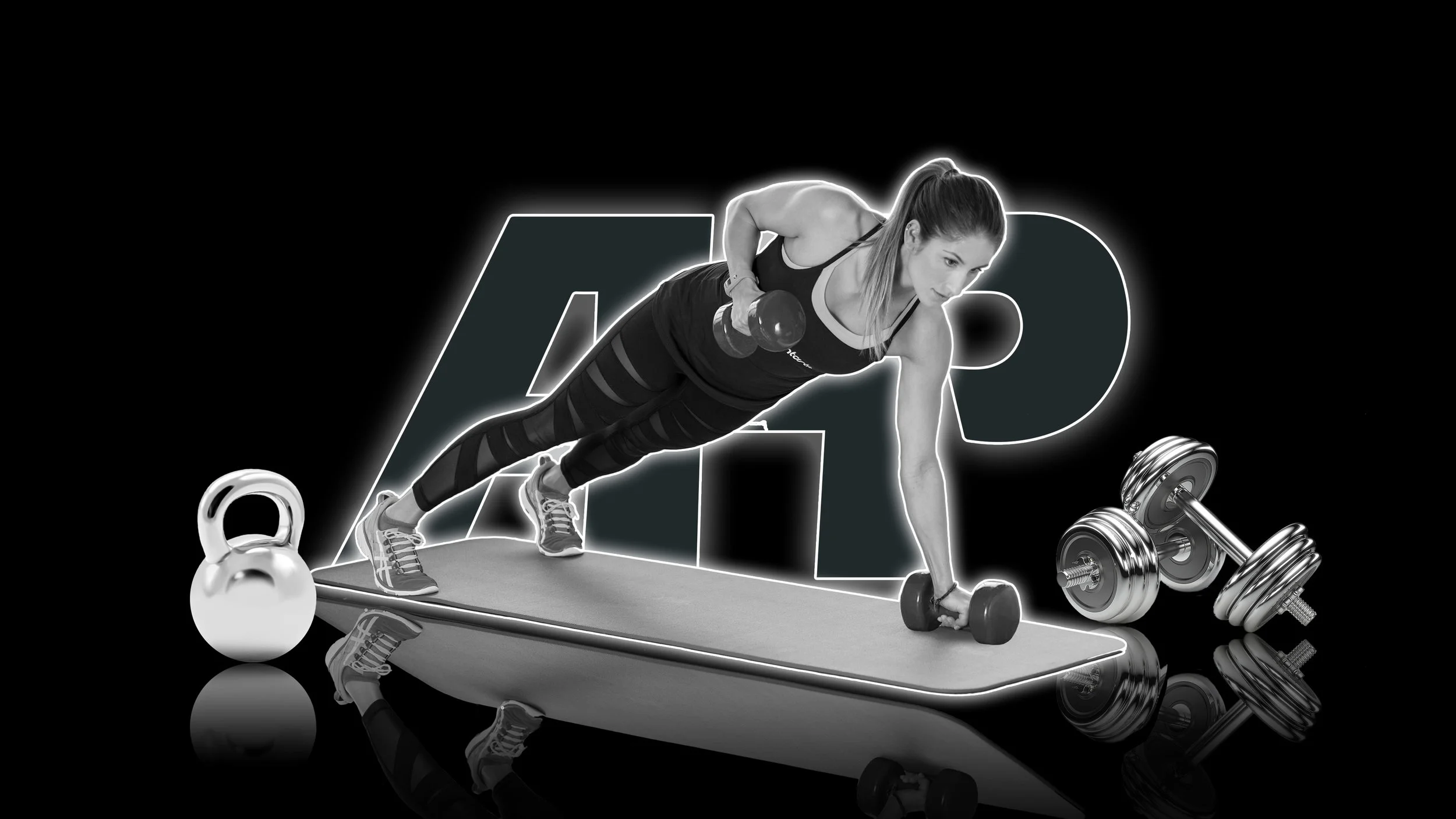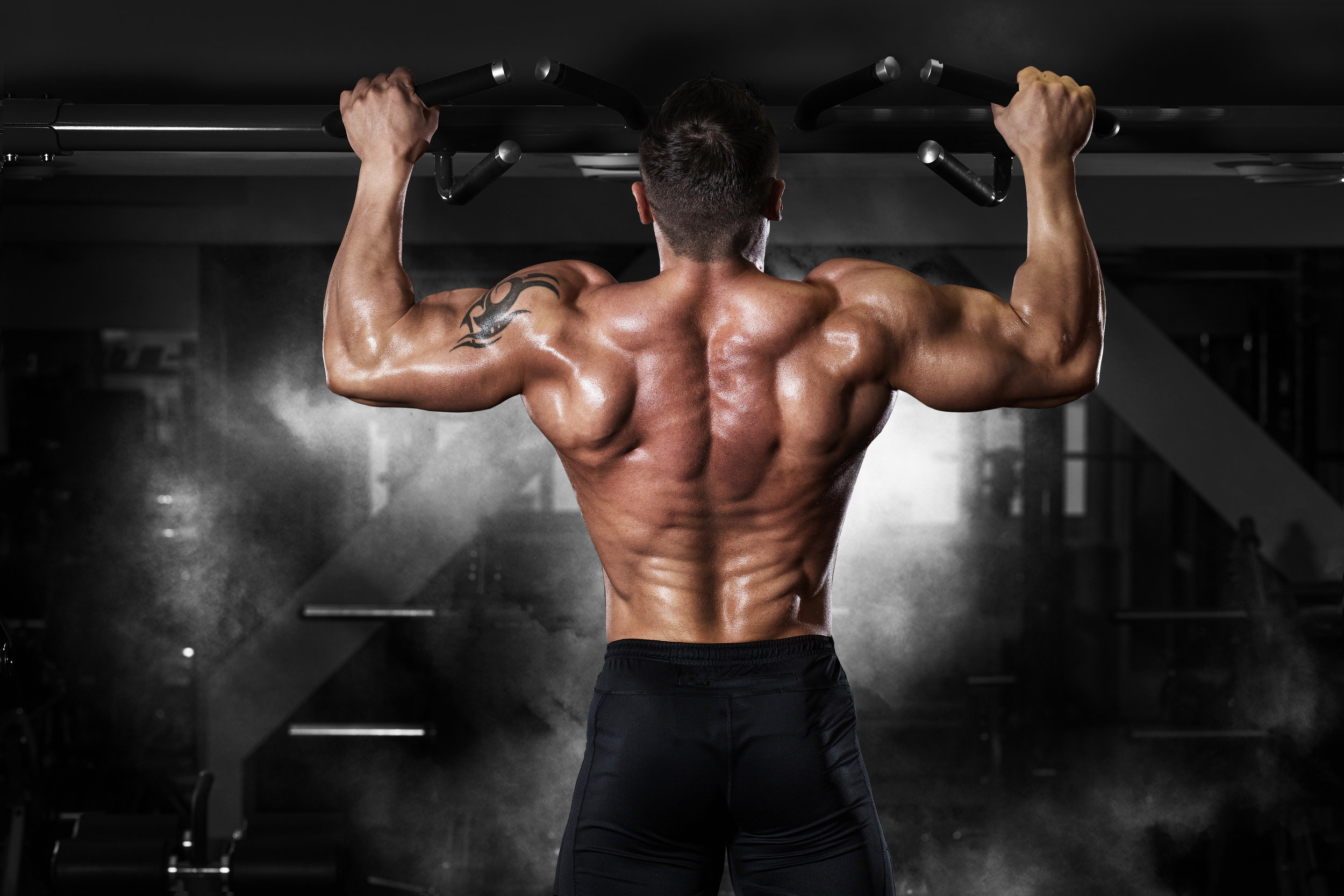Increase Lat and Back Activation with Rotational Strap Protocol
Dr. Joel Seedman
If you’re looking for a unique but very effective method for targeting your lats try this rotational strap method. Here's one of my awesome clients Matt Jordan applying it to the lat pulldown using standard wrist straps attached to the barbell. Although this isn’t one that you’ll load up with incredibly heavy loads there are several unique benefits not only for improving movement mechanics but also for stimulating functional strength and size in the upper torso. Here’s why you would use this variation.
1. The straps create a more unstable and vulnerable bar attachment. Because you’ll be gripping the hanging straps several inches or more below the height of the anchor point on the bar, this causes the bar to be more susceptible to tilting, swaying, shifting or rotating. If you begin to pull more from one arm or allow one shoulder to elevate higher than the other, or you use excessive momentum, these deviations will be magnified as you’ll begin to loose control of the bar attachment. In essence you’ll be forced to use smooth, crisp, symmetrical, and precise vertical pulling mechanics to keep this locked in.
2. This rotating strap lat pulldown variation absolutely crushes the grip as you’ll have to pinch the daylights out of the wrist straps to keep the handles from slipping out of your hands. If you’re in need of a lat pulldown variation to crush your hands, grip, and forearms, this one’s tough to beat. You can also use towels to crush the grip even further but unfortunately it can take away slightly form the rotational movement which leads me to my next point.
3. This specific set up allows a very natural rotational pulling motion to occur rather than the overly rigid grip attachment you would typically find with a standard lat bar setup. In essence you’ll be using a fully pronated grip at the top position and gradually rotating to a fully supinated grip as you reach the fully contracted bottom position. Besides being very conducive for reinforcing proper and smooth scapulohumeral rhythm and centrated glenohumeral joint mechanics (locked in shoulder joint), the rotational movement is also very effective for stimulating significant lat activation and growth
The reason for this is that the overhand or pronated position allows a greater lat stretch while the underhand or supinated position produces a more forceful contraction in the lats at the end of the concentric pull. This produces both mechanical tension and muscle damage (to a moderate degree) as well as a degree of metabolic stress and local occlusion. As a result the stimulation and muscle mind connection you’ll receive to the lat muscles will be significant to say the least even though the load will be relatively light. However, for those suffering with joint issues and overuse injuries, having access to a lat exercise that allows you to use lighter therapeutic loads while simultaneously crushing the lats is always a welcome bonus
If you feel like grip strength is more of a limiting factor during these, try pre-exhausting your lats immediately prior to the pulldown using some form of kettlebell, dumbbell, or barbell pullover. You can also use straight arm pulldowns with bands or a cable system for more constant tension on the lats. In fact this is exactly what I had Matt do during this workout and his lats were pummeled for several days. Typically 2-3 sets of 5-8 repetitions will more than suffice for this pulldown.
Band Strap Variation
If you want to take things a step further and increase the overall intensity you an perform these pulldowns using the hanging band strap method. The kneeling variation also adds to the difficulty and effectiveness.
The kneeling position helps to ensure optimal core activation while reducing the risk of excessive lumbar extension. The band strap protocol provides several unique benefits.
First, it requires the lifter to use incredibly strict and controlled mechanics or else the bands and bar will begin to bounce and oscillate. In addition, the unique grip position is very conducive for performing a rotational pulling protocol. Simply put the lifter can pronate in the top stretched position allowing further elongation and lengthening of the lats. In contrast as they move and rotate into the bottom contracted position a supinated grip can be implemented which creates additional tension in the lats while also ensuring a more packed and centrated shoulder joint.
Lastly, due to the incredibly strict mechanics and lack of movement involved this lat pulldown variation helps to instill proper range of motion at both ends of the lat pulldown. For instance most individuals over-stretch at the top position and over-pull in the contracted position. Incorporating the kneeling position in conjunction with the band strap method helps teach the lifter to find a more compact yet ideal range of motion rather than an excessively large range of motion. Simply put, if you use an exaggerated range of motion you’ll create greater instability to the bar thereby providing immediate feedback in regards to your body mechanics. Keep your body and the bar as stable as possible and the optimal positioning and range of motion will more likely occur.
Bent Over Rows
The same concept works equally well with bent over rows. It’s actually quite deceptive as it looks fairly simple and low intensity due to the relatively lighter loads but it absolutely thrashes the upper back and lats not to mention the grip and forearms. Although this also isn’t one that you’ll load up with incredibly heavy loads there are several unique benefits not only for improving movement mechanics but for stimulating functional strength and size in the upper torso.
Here’s why you would use this variation.
1. The straps create a more unstable barbell. Because you’ll be gripping the hanging straps several inches or more above the height of the anchor point on the bar, this causes the bar to be more susceptible to tiling, swaying, shifting or rotating, If you begin to pull more from one arm, allow one shoulder to protract more than the other, or you use excessive momentum, these deviations will be magnified as you’ll begin to loose control of the bar. In essence you’ll be forced to use smooth, crisp, symmetrical, and precise rowing mechanics to keep this locked in.
2. This rotational strap bent over barbell row variation absolutely crushes the grip as you’ll have to pinch the daylights out of the wrist straps to keep the handles from slipping out of your hands. If you’re in need of a rowing variation to crush your hands, grip, and forearms, this one’s tough to beat. It can also be performed with towels which works the grip even further however you won’t be able to achieve as much rotation of the shoulders which leads me to the next point.
3. This specific set up allows a very natural rotational pulling motion to occur rather than an overly fixed pronated or supinated grip. In essence you’ll be using a fully pronated grip in the bottom position and gradually rotating to a fully supinated grip as you pull into the fully contracted top position. Besides being very conducive for reinforcing proper and smooth scapulohumeral rhythm and centrated glenohumeral joint mechanics (locked in shoulder joint), the rotational movement is also very effective for stimulating significant lat activation and growth The reason for this is that the overhand or pronated position allows a greater lat stretch while the underhand or supinated position produces a more forceful contraction in the lats at the end of the concentric row.
This produces both mechanical tension and muscle damage (to a moderate degree) as well as a degree of metabolic stress and local occlusion. As a result the stimulation and muscle mind connection you’ll receive to the lat muscles will be significant to say the least even though the load will be relatively light. However, for those suffering with joint inflammation, overuse injuries, or low back pain during bent over rows, having access to a rowing exercise that allows you to use lighter therapeutic loads while simultaneously crushing the lats is always a welcome bonus
Single Leg Bent Over Row Variations
Here I'm combining two of my favorite protocols into one unique exercise using the eccentric isometric single leg RDL in conjunction with the rotational strap method.
Also notice the use of the thick mat under my foot to increase the instability and facilitate greater foot and ankle activation as well as overall proprioception. Lastly, pay close attention to the single leg hip hinge position. It involves a 90 degree bend in the back leg with ankle dorsiflexion as well as ample knee bend in the support leg all of which represent proper single leg hip hinge mechanics. Be prepared for a serious burn to your entire backside with this brutal exercise.
Trap Bar Bent Over Row Variation
If you’re looking for a unique and effective exercise that crushes your entire posterior chain, enhances postural positioning, and improves shoulder mechanics, then you’ll want to give this movement a try. Essentially you’re performing a combination of bent over rows and RDL’s with a trap bar while using the rotational grip band strap method as demonstrated by my awesome client Leslie Petch.
I’m a huge fan of traditional trap bar rows as having the hands positioned to the sides of the body is very conducive for helping engage the lats while also reinforcing proper posture and shoulder positioning. However, I’m also a big fan of using a rotational grip during rows such as rope rows and ring rows as the rotational nature of the hands shifting from a pronated to supinated position further enhances lat activation and shoulder positioning. That’s because the pronated grip in the stretched position helps produce an even greater stretch and elongation of the lats while the supinated/neutral position in the top maximizes the lat contraction and squeeze in the concentric position.
With that said, I can’t think of any rowing exercise with the exception of this trap bar band strap row that allows the lifter to combine these two aforementioned rowing techniques. In other words the lifter gets the benefits of both the rotational grip stimuli’s and side-body arm placement at once which no other protocol can provide. While you can try employing this technique using kettlebells placed to the sides of the body, once you begin using any substantial loading the larger kettlebells end up running into the knees and thighs making it feel very unnatural and uncomfortable.
Besides, the enhanced kinematics produced from this rotational band strap bent over trap bar row, the bands also provide a highly unstable and volatile loading protocol that literally force the lifter to use perfectly smooth and dialed in mechanics. Any shifting, excessive momentum, or postural deviations will make it very difficult if not impossible to maintain control of the trap bar.
Straight Arm Lat Pulldown Variations
Straight arm lat pulldowns and variations thereof are highly effective for targeting the lats and core as well as the triceps, chest and shoulders. However, many individuals rely on momentum and sloppy form ultimately causing various technique issues including excessive range of motion, asymmetrical pulling, faulty shoulder mechanics, and poor spinal alignment. Although there are a number of cues and techniques I use to resolve this in my athletes and clients, one of my favorites is incorporating greater instability by using the band strap method as demonstrated by Pittsburg pirates baseball player Austin Meadows.
Essentially you’re incorporating the hanging band technique into the straight arm pulldown. This produces oscillating kinetic energy and subtle perturbations to the bar thereby enhancing proprioceptive feedback and kinesthetic awareness. In other words it helps improve your body mechanics and positioning by helping you tune into your sense of feel. The bar also has a tendency to tilt to one side if you favor one arm or pull asymmetrically. In addition, the lifter is forced to use strict and smooth mechanics to minimize the bouncing effect. Just be prepared to feel your upper back, lats, core, triceps, and other upper body muscles get torched.
Lastly, the grip also gets thoroughly taxed which provide an additional shoulder stabilization and centration effect through concurrent activation potentiation. In other words it improves shoulder stability through full body tension. Try incorporating several sets of 6-10 reps during your next upper body or back workout.
Angles 90 Grippers
Here’s a quick example of some of the various upper body movements that can be performed with the grippers from Angles-90 (use discount code JOEL.10 to get 10% off) as I demonstrate alongside several of my athletes and clients including Ike Onike, Leslie Petch, Ben Lai, Marquell Beckwith, Eric McIntyre, and Cali Shadburn. These deceptive little tools are one of my favorite new training toys as they provide multiple benefits very similar to the band strap method discussed above.
First, this allows the lifter to perform traditional bent over rows, pullups, inverted rows, and lat pulldowns using a rotational arm movement. The rotational arm movement not only reduces stress to the elbows, wrists, and shoulders, but it also taxes the lats more aggressively. That’s because the pronated position allows greater stretch in the eccentric position whereas the supinated underhand grip allows greater squeezing and contraction during the concentric phase.
Additionally these grippers (similar to the band strap method) are also very sensitive to asymmetrical pulling mechanics particularly during barbell rows, seated cable rows, and lat pulldowns. If the lifter pulls with one side more than the other it causes the bar to tilt and shift. As a result it helps correct the various asymmetrical pulling aberrations the lifter might be prone too. Besides the incredible versatility as well as the joint friendly positions these offer. They’re also quite affordable and can be easily attached to any barbell or cable attachment.
The Angles-90 grippers can also be applied to deadlifts and lunge variations. Here’s a quick example of some of the various moves I demonstrate alongside several of my clients and NFL athletes including Leslie Petch, Mazi Ozgobonna, Julian Williams, Elizabeth Yates, and Charlene Harrison.
With that said, the Ankles-90 grippers are incredibly conducive for deadlift variations including squat stance (semi-sumo), deficit deadlifts, single leg deadlifts, snatch grip deadlifts and more. That’s because the handles can be rotated and pulled back behind the lifters shins so that the load is essentially closer to the center of mass similar to a trap bar. Additionally the handles fit perfectly between the legs when performing my go-to squat stance deadlifts as it literally has the same feel as hold a heavy dumbbell or two kettlebells between the legs. In fact I would go as far as saying that when it comes to barbell deadlifts, the Angles-90 grips might be the safest way to perform them.
Hack lunges and hack Bulgarians squats are also ideal for performing with these tools. That’s because the lifter can move through a full range of motion unlike the traditional variations (where you’re gripping the actual barbell) and the bar runs into the thighs midway up. Lastly the grippers do provide a slight degree of instability that requires the lifter to hone in on their form and minimize sloppy technique and aberrant mechanics.
If you need more information about improving shoulder health and function, check out this article HERE.

















































